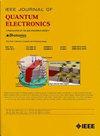基于 LSTM-CNN 的高精度、快速分布式光学频域反射仪温度数据解调算法
IF 2.1
3区 工程技术
Q3 ENGINEERING, ELECTRICAL & ELECTRONIC
引用次数: 0
摘要
本文提出了一种基于 LSTM-CNN 的解调算法,可同时实现分布式光频域反射仪(OFDR)温度数据的解调。对于分布式光纤的局部测量范围,LSTM-CNN 的平均绝对误差(MAE)仅为 0.0393,平均解调时间仅为 0.1507 秒。与交叉相关算法、多层感知器(MLP)、极限学习机(ELM)、长短期记忆(LSTM)和卷积神经网络(CNN)相比,MAE 分别降低了 85.98%、77.23%、88.25%、80.95% 和 91.82%,平均时间分别缩短了 38.19 倍、8.71 倍、3.28 倍、1.37 倍和 2.45 倍。对于分布式光纤的全测量范围,LSTM-CNN解调出的温度分布曲线与实际温度分布曲线一致,平均解调时间为0.371秒,为分布式OFDR传感系统的温度数据解调提供了一种新方法。本文章由计算机程序翻译,如有差异,请以英文原文为准。
High Precision and Fast Distributed Temperature Data Demodulation Algorithm of Optical Frequency Domain Reflectometer Based on LSTM-CNN
A demodulation algorithm based on the LSTM-CNN is proposed to simultaneously achieve the demodulation of temperature data from distributed optical frequency domain reflectometry (OFDR). As for the local measurement range along the distributed fiber, the LSTM-CNN can achieve an average mean absolutely error (MAE) of only 0.0393 and the average demodulation time is only 0.1507 seconds. The comparison with the cross-correlation algorithm, Multi-Layer Perceptron (MLP), Extreme Learning Machine (ELM), Long Short-Term Memory (LSTM), and Convolutional Neural Network (CNN) demonstrates that the MAE is reduced by 85.98%, 77.23%, 88.25%, 80.95%, and 91.82%, and the average time is faster 38.19 times, 8.71 times, 3.28 times, 1.37 times, and 2.45 times, respectively. As for the full measurement range of the distributed fiber, the temperature distribution curve demodulated by LSTM-CNN is found to be consistent with the actual temperature distribution curve and the average demodulation time is 0.371 seconds, providing a new method for the temperature data demodulation in the distributed OFDR sensing system.
求助全文
通过发布文献求助,成功后即可免费获取论文全文。
去求助
来源期刊

IEEE Journal of Quantum Electronics
工程技术-工程:电子与电气
CiteScore
4.70
自引率
4.00%
发文量
99
审稿时长
3.0 months
期刊介绍:
The IEEE Journal of Quantum Electronics is dedicated to the publication of manuscripts reporting novel experimental or theoretical results in the broad field of the science and technology of quantum electronics. The Journal comprises original contributions, both regular papers and letters, describing significant advances in the understanding of quantum electronics phenomena or the demonstration of new devices, systems, or applications. Manuscripts reporting new developments in systems and applications must emphasize quantum electronics principles or devices. The scope of JQE encompasses the generation, propagation, detection, and application of coherent electromagnetic radiation having wavelengths below one millimeter (i.e., in the submillimeter, infrared, visible, ultraviolet, etc., regions). Whether the focus of a manuscript is a quantum-electronic device or phenomenon, the critical factor in the editorial review of a manuscript is the potential impact of the results presented on continuing research in the field or on advancing the technological base of quantum electronics.
 求助内容:
求助内容: 应助结果提醒方式:
应助结果提醒方式:


